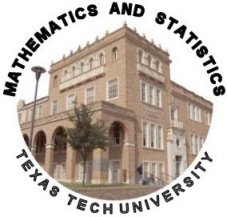Workshops for Students
Microbes Count: Modeling Phage Growth
Dr. Linda Allen, Horn Professor
Bacteriophage, also known as phage, are viruses that infect bacteria. Phages are some of the most common
and widely distributed biological quantities on earth. They are found in our intestines, the soil, and in
fresh and sea water. Each phage only infects a specific type of bacteria. Therefore, phages have been used
as alternatives to antibiotics to control pathogenic bacteria, especially antibiotic-resistant bacteria.
We will use a mathematical model developed by BioQuest to investigate how phages infect a bacterial cell,
reproduce within the cell, then lyse the cell, killing the bacteria and releasing more phage that go
on to infect other bacterial cells.
Parallel lines never meet, or do they?
Dr. Lars Christensen, Associate Professor
It is one of Euclid's axioms that parallel lines never meet, but every time we let our eyes follow a straight stretch of highway all the way to the horizon, we doubt it. Of course mathematics has a way to treat what we observe. In projective geometry, two parallel lines do meet in a point at infinity! And, actually, a line and a parabola always have two intersection points, provided that one looks carefully, also at infinity, and counts properly.
The Mathematics of Juggling
Dr. Ram Iyer, Associate Professor, and Dr. Arne Ledet, Associate Professor
In juggling, the balls follow distinctive patterns. These patterns can be described mathematically in several ways, for instance as strings of numbers or by means of directed graphs. We will explain these mathematical descriptions, and illustrate how they relate to the actual juggling.
Why Math? Careers and Academic Opportunities for Math Majors
Levi Johnson, Graduate Student
Just at Texas Tech University, there are more than ten different colleges and schools. Students can select majors ranging from English to architecture to political science. So, why would anyone choose to major in mathematics? How does a math degree distinguish someone from an engineering or science degree? How do math students compare on pre-professional tests like the LSAT or MCAT? This workshop will attempt to deal with these questions and more.
How to Kill a Zebra and Raise a Family
Dr. Clyde Martin, Horn Professor
The lions of Africa have a very formal arrangement in families and related lions. The questions that we will pose are related to how large a pride should be. We will ask such questions as: "Why aren't there 100 players on the field during a football game instead of 11? Why aren't football teams restricted to two players? Why doesn't a pride of lions have 100 members? Why don't lions live alone? We will try to understand the mathematics of these questions and then ask and answer the most important question: What kinds of problems can we study if we know mathematics?
Codebreaking 101
Dr. Chris Monico, Associate Professor
Mathematics is the search for, and exploitation of, structure. We search for structure everywhere
and use it to uncover ever more well-hidden structure. In this talk, we'll discuss some of the subtle
structure present in the written English language (similar structure is necessarily present in every written
and spoken language). We will give the students a historically important piece of ciphertext,
a 5 minute history lesson to put it in perspective, and then split the students off into groups to break
the cipher.
What's Calculus Really All About?
Dr. Brock Williams, Associate Professor
What's the big deal about calculus? Why do we need calculus anyway? Isn't algebra enough math for anybody? In this workshop we'll describe what calculus really is, why it's so much more powerful than algebra, and how we can solve the problems that arise in the real world.
|

